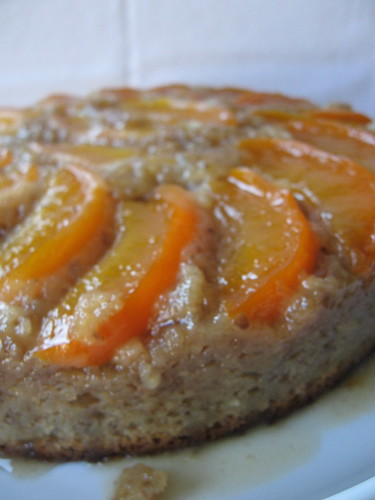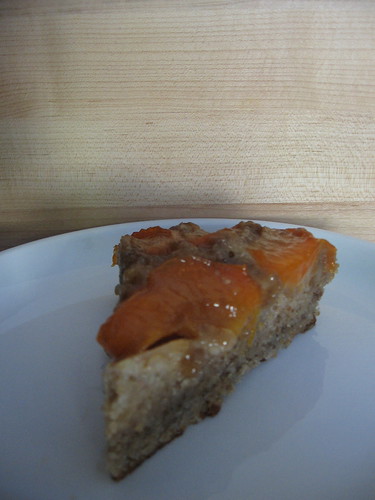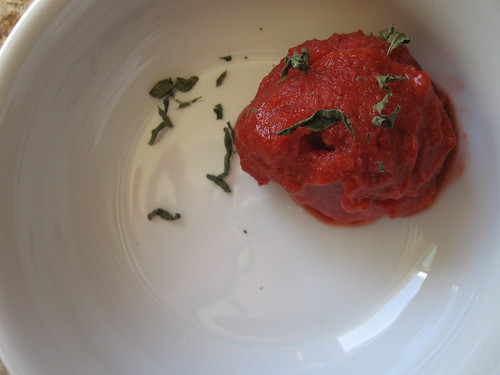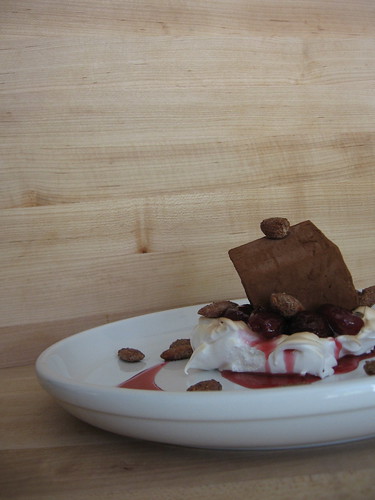Now, though, is the time for green beans and the end of cherry season, for the first baby zucchini and sweet stone fruit. After several weeks of Southern California's famous June Gloom, strawberries are still lingering, and while the tomatoes on my patio garden are blooming and showing small fruit, the specimens at the markets are getting fatter, redder, and sweeter.
A rainy spring in the plum and apricot Mecca north of L.A. has made for an uncertain apricot season; my preferred Blenheim variety was almost nonexistent last summer, so I'm not going to wait and see what July brings.

After getting home from the market last week, I looked at my fruit selection and wondered what the heck I was going to do with it all. Stone fruit, strawberries, tomatoes and cheese are my unabashed food splurges—while my husband is left sputtering at the price, I happily fill my bags with aromatic apricots and unblemished nectarines, controlled only by the limited amount of cash that I bring and a strong aversion to food waste. However profligate I may be while at the market, I always try to plan my meals to avoid the (sometimes inevitable) bag of who-knows-what from who-knows-when that we all ignore in the bottom of the crisper drawer.
Good intentions and careful meal planning aside, I got home last week with six beautiful apricots and a vague idea for some sort of cake. I flipped through my cookbooks and clicked on countless blogs; I thought about making my apricot yoghurt cake, which I discarded as uninteresting, or this fantastic almond torte with apricots, which was rejected because I'm hoarding my almonds for another purpose. While rifling through my pantry searching for ingredients, I saw a bag of walnut halves and remembered my husband's half-jesting request that I make walnut cake once a week for the rest of eternity.

It made sense—we see dried apricots and walnuts used together quite often, but fresh apricots are more often paired with almonds. A little more research, a few tweaks to the cake recipe, and Apricot-Walnut Upside-Down Cake was born.
The first version was good - the walnut cake was dense and moist, with an almost pudding-like texture where the apricot juices and caramel had soaked in. At the same time, my taste for less-sweet desserts didn't do this cake any favors; when I cut the amount of caramel, the tart apricots were a bit too harsh. A second trip to the market and second batch of apricots later, I doubled the amount of caramel and tried again.

Perfection. The apricots are tart but flavorful, an appropriate contrast to the sweet cake. The cake is delicious with whipped cream, but it stands alone.
Apricot-Walnut Upside-Down Cake
Inspired by multiple recipes, not least Ruch Reichl's Apricot Upside-Down Cake
I used Lorna apricots for this cake, a large variety that is slightly bland and also a bit crunchy when raw; after cooking, they hold their shape well, and the flavors develop but don't overwhelm the nutty cake.
For the caramel:
4 tablespoons (½ stick) butter
⅓ cup brown sugar, packed
3 tablespoons granulated sugar
For the cake:
3-4 large or 6-8 small apricots
¾ cup ground walnuts, lightly packed (from one scant cup walnut halves or pieces)
1¼ cups unbleached all-purpose flour
¾ cup granulated sugar
¼ cup brown sugar, packed
1½ teaspoons baking powder
¼ teaspoon salt
1 large egg, room temperature
¾ cup milk (I used whole), room temperature
1 teaspoon vanilla extract
½ cup (1 stick) butter, melted
Preheat oven to 375ºF. Lightly butter an 8 inch round pan with at least 2 inch sides; set aside.
To make the caramel, melt the butter in a skillet over moderate heat. Add the sugars and stir gently; let cook 3 minutes; the butter will bubble but the sugars will not be completely dissolved. Pour the mixture into the baking pan and quickly spread it across the bottom. Cut the apricots into pieces and arrange them over the caramel; large apricots can be cut into eigths, while smaller apricots can be cut into quarters or halves; set aside.
Grind the walnuts in a food processor until the consistency of coarse meal; mix in a large bowl with flour, sugars, baking powder and salt. Beat the egg together with the milk and add to the dry ingredients. Stir until barely combined, then add the melted butter and stir until smooth.
Pour the batter gently over the apricots and transfer to the oven. Bake about one hour, or until a skewer inserted in the center comes out clean. Remove from the oven, hold an inverted plate tightly over the pan, and carefully flip. Gently and slowly remove the cake pan away from the plate—hot caramel will drip down the sides, and some of the edges may crumble a bit. Let the cake cool, then replace any dislodged pieces of apricot.
Serve plain, or with whipped cream or ice cream.
Serves about 8





